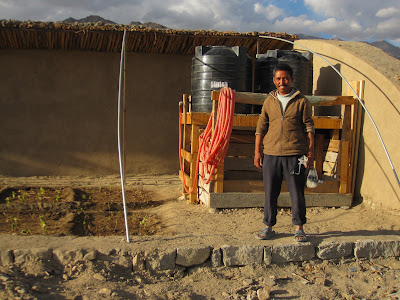The water system in Leh is much different than what we students, living in the U.S., are used to. It is extremely rare that I turn on a faucet and not have a steady stream of clean water flow out. There is a chasm separating my understanding of my tap water, clean enough to drink, and the source from which that water originates. Leh’s water system is not as simple as the ones we have become accustomed. Often the turn of a knob brings only gurgling sounds and a spatter; if you have running water at all. Many families in Leh do not have running water in the household, instead they must head out multiple times a day to retrieve water from…water trucks, community wells,…?. Hot water is another luxury in Leh. If you are able to have a hot water source, it is often sporadic and unpredictable. Municipal water, and the city’s irrigation poses an entire other set of concerns. The town of Leh is not equipped to treat their water, so the water that is distributed to the public is susceptible to many health hazards. The following is an account of my research and observations into Leh’s water system:
-Leh’s water comes from two sources; well water, and snow melt. Wells are dug at two depths. Private residences that have their own water wells, usually dig theirs to a depth of 15 ft. This is the channel for the local snowmelt that travels beneath the ground’s surface. The city digs it’s municipal wells to a depth of 80-90ft, at which depth it can access the local aquafir.
-Ground water is pumped into the city’s large water tank. This tank is placed at the foot hills of the mountains, at an elevation above most of the city’s population so as to allow gravity to feed the pipes below.
-Walking around Leh, I see large water tanks hovering from beyond the parapet of the buildings. These water tanks are fed by personal pumping systems that pull the well water into the tank.This allows water to be stored high and gravity fed, which allows the residents to have a steady supply despite the inconsistent power supply in Ladakh.
-Municipal water spigots are few and far apart, and often placed along the city’s streets. On my short walk from our hotel to the breakfast restaurant next door, I regularly pass by four or five locals standing with a line of water jugs beside them. As many houses do not have their own water supply, they must walk to this spigot multiple times a day, buckets in hand, ready to fill and carry it back home. These spigots are often simply pipe sticking out of the ground with a faucet attached. The water pressure is low and so the simple task of getting water takes a significant amount of time to accomplish.
.png)
.JPG)
-Another significant source of water is water trucks. Often waking me up before my alarm, these trucks sound a distinctive horn around 6am. These trucks bring tap water from Chanspa, a neighboring town, and sell it to local residents.
.JPG)
-An additional source of water is local wheelbarrows with metal tanks of water covered with a plastic sheet. Looking down from my hotel window in the morning I see men wheeling these carts around on foot. Residents then come out and dunk their buckets into the water, and he moves onward.
.JPG)
-Irrigation canals wind throughout the entire city. These canals vary in the composition; some appear to be small creeks, some are paved out of stone, and the newest are formed from concrete. The canals that run alongside the busy streets are sporadically covered by metal grating.

The streams twist between the backs of houses and sometimes cross beneath streets. The water source of these canals is usually snowmelt. This means that water may be scarce, if the day is too cold or overcast, or that it may rush and overflow the roads on a particularly warm day. Although these are meant to feed the city’s greenery, residents have found other ways to utilize this free and constant water source. Many residents can be found doing their laundry, or washing their dishes in this water. The lack of municipal protection of this water source allows for multiple avenues of contamination. Animals such as dogs, cows and donkeys can be found bathing and defecating in these streams. The residents themselves sometimes channel their sewage to these open canals allowing for serious health concerns.

-The excess of this water is eventually fed back into the Indus River. There is no municipal water drainage system set up and so the water, mostly contaminated, travels beneath ground, downhill, and finds its way to the Indus.
Global warming is also having an impact on the region the local rainfall has been steadily increasing. Although this seems to be a positive change to such an arid climate, the city cannot support increased rainfall. The earth itself is unsuitable for rainfall, and drains poorly. It is so dry and compact that the water does not fully absorb to nourish it. Instead it just travels superficially across the surface and leads back to the Indus. The irrigation canals have started to overflow with the increase of snowmelt, as they were not created with room for increase water flow. The local construction methods are also not conducive to moist climate. As the buildings are almost entirely made of mud brick, the ever increasing amount of rain and snowmelt will eventually lead to the degradation of the city’s architecture as well as its urban topography.
Written by Angela Previdelli
































.png)
.JPG)
.JPG)
.JPG)


.png)
.png)
.png)

.png)
.png)
.png)
.png)
.png)
.png)
.png)
.png)
.png)
.png)